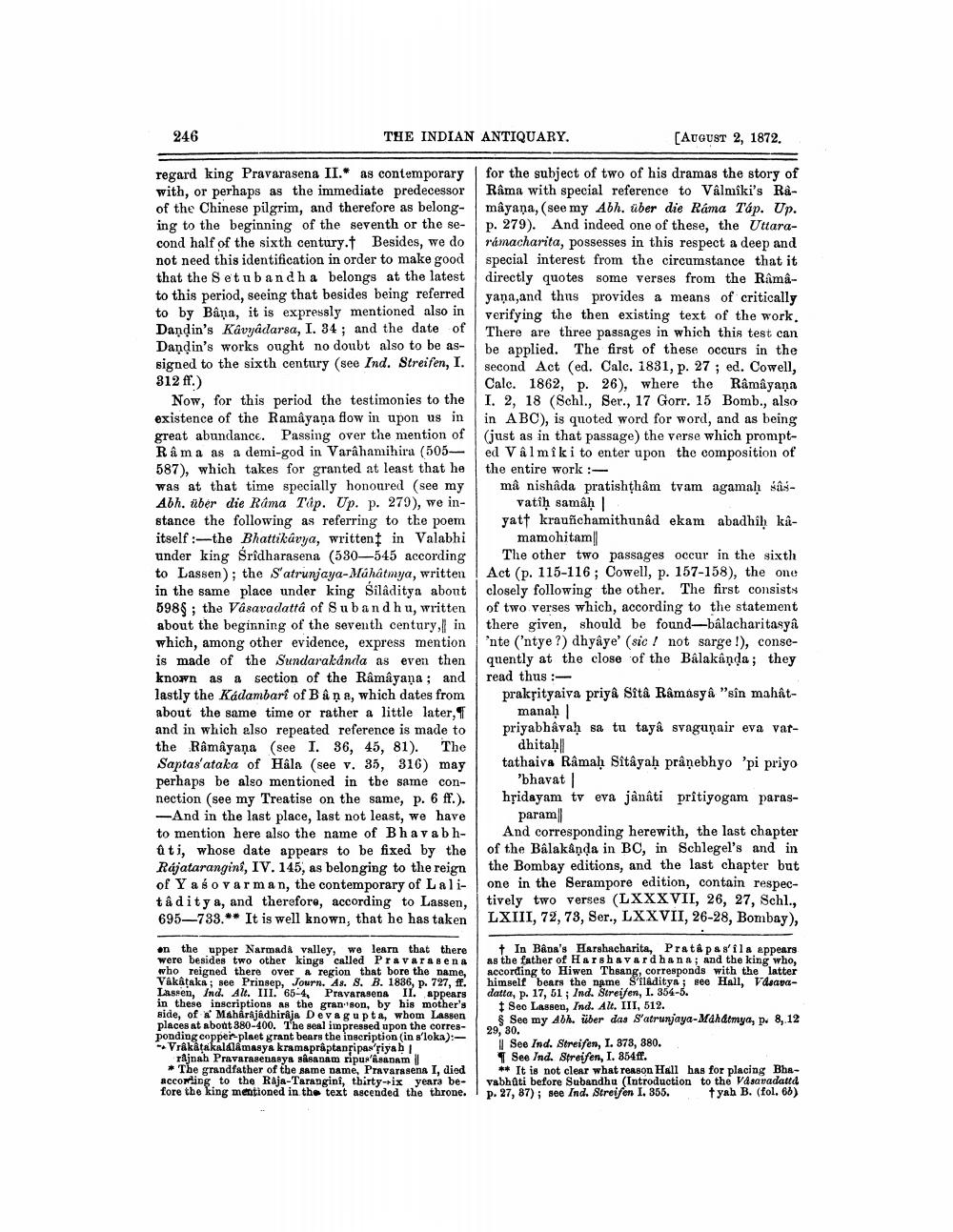________________
246
THE INDIAN ANTIQUARY.
[AUGUST 2, 1872.
regard king Pravarasena II.* as contemporary with, or perhaps as the immediate predecessor of the Chinese pilgrim, and therefore as belong- ing to the beginning of the seventh or the se- cond half of the sixth century. Besides, we do not need this identification in order to make good that the Setubandha belongs at the latest to this period, seeing that besides being referred to by Bâna, it is expressly mentioned also in Dandin's Kávyâdarsa, I. 34 ; and the date of Dandin's works ought no doubt also to be assigned to the sixth century (see Ind. Streifen, I. 312 ff.)
Now, for this period the testimonies to the existence of the Ramayaņa flow in upon us in great abundance. Passing over the mention of Rama as a demi-god in Varahamihira (505- 587), which takes for granted at least that he was at that time specially honoured (see my Abh. über die Ráma Táp. Up. p. 279), we instance the following as referring to the poem itself :-the Bhattikávya, written in Valabhi under king Sridharasena (530—545 according to Lassen); the S'atrunjaya-Mahatmya, written in the same place under king Siladitya about 5989; the Vasaradattâ of Subandhu, written about the beginning of the seventh century, in which, among other evidence, express mention is made of the Sundarakanda as even then known as a section of the Râmâyaņa; and lastly the Kadambari of B & ņa, which dates from about the same time or rather a little later, and in which also repeated reference is made to the Râmâyaņa (see I. 36, 45, 81). The Saptas'ataka of Hála (see v. 35, 316) may perhaps be also mentioned in the same connection (see my Treatise on the same, p. 6 ff.). -And in the last place, last not least, we have to mention here also the name of Bhavabhati, whose date appears to be fixed by the Rájatarangini, IV. 145, as belonging to the reign of Yaso varman, the contemporary of Lalitaditya, and therefore, according to Lassen, 695—733.** It is well known, that he has taken
for the subject of two of his dramas the story of Râma with special reference to Valmiki's Ràmayaņa, (see my Abh. über die Ráma Táp. Up. p. 279). And indeed one of these, the Uttararamacharita, possesses in this respect a deep and special interest from the circumstance that it directly quotes some verses from the Ramayana,and thus provides a means of critically verifying the then existing text of the work. There are three passages in which this test can be applied. The first of these occurs in the second Act (ed. Calc. 1831, p. 27; ed. Cowell, Calc. 1862, p. 26), where the Ramayana I. 2, 18 (Schl., Ser., 17 Gorr. 15 Bomb., also in ABC), is quoted word for word, and as being
just as in that passage) the verse which prompted Valmiki to enter upon the composition of the entire work :må nishada pratishthâm tvam agamah as
vatih samah yatt krauñchamithunâd ekam abadhih ka
mamohitam The other two passages occur in the sixth Act (p. 115-116; Cowell, p. 157-158), the one closely following the other. The first consists of two verses which, according to the statement there given, should be found-bâlacharitasya inte ('ntye ?) dhyâye' (sic! not sarge !), consequently at the close of the Balakanda; they read thus : praksityaiva priya Sita Râmasya "sin mahat
manah ! priyabhavaḥ sa tu taya svaguņair eva var
dhitah tathaiva Râmaḥ Sítâyah prâņebhyo 'pi priyo
'bhavat hridayam tv eva jânâti prîtiyogam paras
param And corresponding herewith, the last chapter of the Balakanda in BC, in Schlegel's and in the Bombay editions, and the last chapter but one in the Serampore edition, contain respectively two verses (LXXXVII, 26, 27, Schl., LXIII, 72, 73, Ser., LXXVII, 26-28, Bombay),
on the upper Narmada valley, we learn that there were besides two other kings called Pravarasena who reigned there over a region that bore the name, Vâkâtaka; see Prinsep, Journ. As. S. B. 1886, p. 727, ff. Lassen, Ind. Al. III. 65-4, Pravarasena 11. appears in these inscriptions as the gran son, by his mother's side, of Maharajadhiraja Devagupta, whom Lassen places at about 380-400. The seal impressed upon the corresponding copper-plaet grant bears the inscription (in s'loka): - Vråkåta kalalamasya kramapraptansipas'riyab
rájnah Pravarasenasya sasanam ripur'Alsanam
The grandfather of the same name, Pravarasena I, died according to the Raja-Tarangini, thirty--ix years be- fore the king mentioned in the text ascended the throne.
+ In Bâna's Harshacharita, Pratápeg'ila appears as the father of Harshavardhana ; and the king who. according to Hiwen Thsang, corresponds with the latter himself bears the name S'iladitya ; see Hall, Vdsapadatta, p. 17, 51; Ind. Streifen, I. 354-5.
Seo Lassen, Ind. Alt. III, 512. $ See my Abh. über das S'atrunjaya-Mahatmya, p. 8, 12 29, 30,
See Ind. Streifen, L. 373, 880.
See Ind. Streifen, I. 854ff. ** It is not clear what reason Hall has for placing Bhavabhati before Subandhu (Introduction to the Vasavadatt& p. 27, 87): see Ind. Streifen I. 355. yah B. (fol. 66)
ka):
pas Tiyab
#cro
grandfather daya sasana




